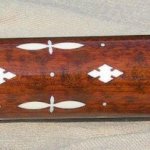CNC vs Non-cnc is a complicated issue in many cases. Neither is inherently always better than the other.
In any machine, there are a number of variables.
Using jigs and tooling, a manual machine may easily be as accurate and precise as a cnc machine.
A cnc will be easier to configure to new tasks and is likely more versatile than a manual setup.
A manual machine is likely simpler for a lower skilled person to use. A well set up manual machine can have a five minute learning curve. Turn on machine, move from point A to point B.
Neither machine will be accurate or precise if it is poorly set up, has sloppy components, has dull cutters, is poorly maintained, etc..
It is arguable that a manual machine with good components is better for many parts of cue building. Cutting tapers, cutting tenons, boring holes, cutting splices, etc. can all be set up to be extremely precise and accurate on a manual machine for a lot less cost than a CNC machine.
Cutting intricate inlays is hands-down more suited for a CNC machine.
Using the same machine to do multiple tasks is likely more suited to a CNC machine, but with the right jigs and tooling, a person can make a relatively inexpensive manual machine and turn out the same quality on many of the tasks. I designed and built a tapering machine that I could change out the guide, raise the spindle and cut short-splice forearms in a few minutes. I made the jig so I could easily and accurately adjust the length of the points. I could also cut butterfly short-splices. All told, about $800 in parts and hours of labor. I built it with hand tools and my first test forearm held ~10" points very evenly. If I set it up and zero'd the machine, I could have a highschool student make a dozen without supervision.
Long and short, both take a different, but overlapping set of skills. One of the most important aspects that is rarely mentioned here is having the ability and tooling to accurately measure. Just because your calipers read 12.50mm doesn't actually mean that your part is 12.50mm. Inspection of parts is a skill set unto itself and not one to be taken lightly when people are talking about less than 0.08mm.
